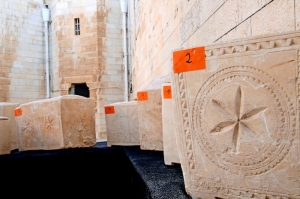|
Displaying items by tag: ancient
Thutmose III thought big.
His Obelisk, however, is being treated at the level of atomic particles.
Since early May, conservators have been cleaning the Obelisk with hand-held lasers. Inch by inch, as if a magic wand were being passed over the hieroglyphs, the flecked pink granite of Aswan, Egypt, has emerged from under Manhattan’s gray pall.
The Obelisk was first erected about 3,460 years ago at Heliopolis, on the outskirts of modern Cairo, to glorify Thutmose III, a pharaoh who has been likened to Napoleon. The Romans moved it to Alexandria, from where it was transported in 1880 to New York City, as a gift from the khedives who then ruled Egypt. It was re-erected on Greywacke Knoll in Central Park in 1881.
He was carved nearly 1,000 years ago from the wood of a giant cryptomeria, a type of cypress native to Japan. Since then, he’s been worshiped as a god, survived a devastating fire, endured a lengthy ocean voyage and delighted generations of Rhode Island art lovers.
Still, there’s a good chance the majestic “Buddha Dainichi Nyorai” — better known as the RISD Museum’s big wooden Buddha — has never had it so good.
Indeed, the massive carving and dozens of other objects have been given a thorough primping and pampering as part of a two-year, $2.7-million renovation of the museum’s top-floor Radeke Building galleries. The new galleries, which house everything from Asian prints and ceramics to ancient Egyptian artifacts to contemporary fashions and textiles, open to the public Friday.
Two pairs of 3,300-year-old trousers found in China's far western Xinjiang region may be the world's oldest, according to state media.
Archeologists in May found animal-fur menswear on the bodies of two mummies, identified as male shamans in their 40s, the state-run China Daily cited scientists as saying.
An international team is working together to repair and preserve the two pairs, which are the oldest yet discovered with a clear resemblance to modern trousers, the report said.
One of the world’s most precious troves of looted antiquities — brilliantly colored burial shrouds from an Andean civilization that flourished a thousand years before Columbus — is on its way back to Peru for a ceremonial handover in Lima.
The 89 embroidered textiles, named for the Paracas peninsula where they were unearthed around 1930 and then smuggled out by the Swedish consul, ended up in possession of the city of Gothenburg and were displayed there in the National Museum of World Culture.
Hundreds of paintings were discovered in the 12th century Cambodian temple complex Angkor Wat hiding in plain sight.
Though thousands of people pass through the religious monument every day, nobody had ever noticed the ancient graffiti on the faded walls. Researcher Noel Hidalgo Tan first saw the red and black pigment on the walls of the monument when he visited and decided to investigate, Smithsonian Magazine reports.
One of the Getty's most prized ancient artworks is hanging in a legal balance this week in Italy's highest court, leaving the L.A. museum's leaders feeling as if they have landed in a Franz Kafka tale, a judicial and bureaucratic nightmare they can neither understand nor escape.
But unlike a hapless Kafka character, the Getty has an inkling as to why its nearly life-size statue, known as "Victorious Youth" or the "Getty Bronze," is back in a maze of judicial and investigative proceedings. And rather than suffer passively, the Getty — the world's richest art institution, with a $6-billion endowment — may well draw a line.

The Louvre’s new outpost in Abu Dhabi, which is slated to open in December 2015, will showcase highlights from its collection during an exhibition in France in May. “Birth of a Museum” will include over 160 objects and will give visitors a glimpse of the museum’s impressive collection as well as demonstrate the project’s cultural and architectural significance.
Louvre Abu Dhabi’s collection, which includes everything from ancient to contemporary artworks, has been gradually growing since 2009. “Birth of a Museum” will present a rare Greek archaic sphinx, an Italian brooch from the 5th century AD, and paintings by Edouard Manet, Rene Magritte, Paul Gauguin, Pablo Picasso, and Cy Twombly. A similar exhibition was held in Abu Dhabi from April 22 through July 20, 2013, at a gallery on the island of Saadiyat, close to where construction for the new museum is underway.
Louvre Abu Dhabi, which was designed by the French architect Jean Nouvel, aims to be a place of conversation between civilizations and cultures. Works on view will be drawn from French collections as well as the museum’s own holdings.
“Birth of a Museum” will be on view at the Louvre in Paris from May 2 through July 28.

The Israel Antiquities Authority announced that police have arrested a group of suspects accused of stealing ancient Jewish burial caskets from a cave near Jerusalem. The thieves were caught with 11 decorative stone ossuaries, or ancient coffins, that the Jewish people used for burial in the Second Temple period, 2,000 years ago. Some of the ossuaries still contain the bones of the deceased.
The suspects, from the West Bank, Jerusalem and Tel Aviv, were arrested on Friday, March 28, as they met prospective Jewish clients at the Hizma checkpoint north of Jerusalem. The ossuaries, which are covered in Hebrew inscriptions and traces of paint, were seized by investigators with the Israel Antiquities Authority’s Unit for the Prevention of Antiquities Robbery.
The Israel Antiquities Authority released a statement saying, “There is no doubt that the ossuaries were recently looted from a magnificent burial cave in Jerusalem.” Officials did not reveal how many suspects were arrested or what charges they may face.
In 1912, Charles Lang Freer, founder of the Freer Gallery of Art in Washington, D.C., put two rare antique biblical manuscripts on public view in his Detroit home. Over 100 years later, the Washington Codex, one of the oldest manuscripts of the four Gospels in the world, and an ancient parchment volume of Deuteronomy and Joshua, are on view in the Freer’s Peacock Room, which was decorated by James McNeill Whistler in 1876.
The last time the manuscripts were exhibited was in 2006, when they were part of a landmark exhibition of Bibles created before the year 1000. Due to their extreme sensitivity to light and fragility, the Peacock Room’s windows will remain shuttered on the third Thursday of each month.
The manuscripts will be on view at the Freer Gallery of Art through February 16, 2014.
An ancient statue sold at auction will be returned to Cambodia after an agreement was signed by Sotheby’s, the work's consignor and federal officials. The figure, which is believed to have been looted from a temple in the Cambodian jungle, has been at the center of a legal battle for nearly two years.
The 10th century sandstone statue depicting a Hindu warrior is estimated to be worth $2 million and was consigned by its long-time owner in 2011. Following the agreement to return the treasure, lawyers from the U.S. Attorney’s Office withdrew allegations that Sotheby’s and the consignor knew of the work’s troubled provenance before importing it for sale. The consignor will receive no compensation for the statue from Cambodia.
A spokesman for Sotheby’s said the auction house was pleased that “the agreement confirms that Sotheby’s and its client acted properly at all times.”
|
|
|
|
|